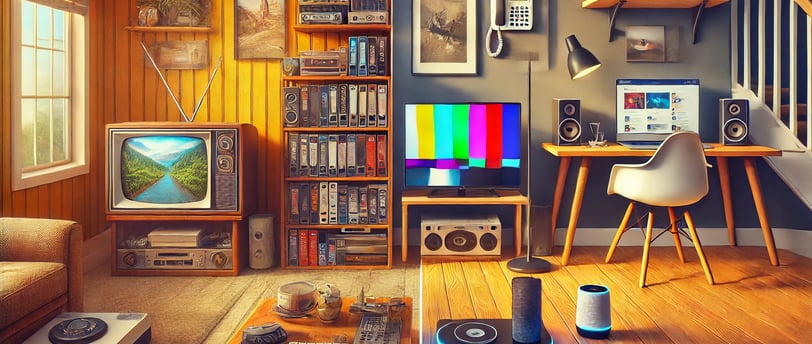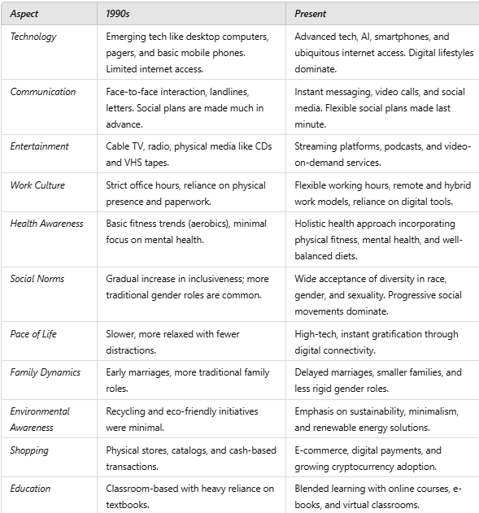The Lifestyle Evolution: A Comparison Between Today and the 1990s.
This blog explores how our lifestyles have evolved from the 1990s to the present, highlighting technology, cultural shifts, and socio-economic changes that shape our daily lives.
B. Rakshita Sharma
11/30/20243 min read


The Lifestyle Evolution: A Comparison Between Today and the 1990s.
Current Lifestyle of People
Technology and Digital Dependence
The present age is dominated by technology in every walk of life. With smartphones, smartwatches, tablets, and devices run by artificial intelligence everywhere, it has reshaped the ways of communication, entertainment, work, and even personal habits.Work: With tools such as Zoom, Slack, and Microsoft Teams, remote working and hybrid models have become prominent.
Leisure: Traditional TV has been replaced by streaming platforms such as Netflix, Disney+, and YouTube.
Shopping: Online shopping through Amazon and eBay is preferred over in-store purchases.
Health and Wellness Consciousness
Modern lifestyles reflect growing awareness of physical and mental health. Many people focus on being fit, mindful, and maintaining a balanced diet, preferring gym memberships, yoga practices, and organic food. Mental health awareness is at its peak, with therapy and meditation becoming normalized.On the other hand, increasing levels of stress and anxiety related to information overload, work pressures, and social comparisons often initiated through social media stand out in contrast.
Social Norms and Diversity
Inclusivity and diversity are central to modern ways of life. Individuals express diverse cultural identities, gender expressions, and sexual orientations more openly. Campaigns such as the LGBTQ+ rights movement, feminism, and anti-racism have also significantly shaped people's conduct in society.Fast-Paced Living
The urgency and immediacy hallmark the current era. Instant messaging, same-day deliveries, and 24/7 connectivity have made patience a rare trait. People expect rapid responses in professional and personal sectors.Environmental Awareness
Contemporary individualism is becoming increasingly obsessed with sustainability. Eco-friendly, renewable energy, and living small are becoming popular ways to fight climate change and lower carbon footprints.Family and Relationships
Family life has dramatically changed. Many people get married much later in life, put career before family, or avoid children altogether. Work-life balance is an issue for most since professional and personal lives are blurring.
Lifestyle in the 1990s
Technology and Media
The 1990s was the time when technology started to thrive but had not yet found its way into everyday life.Communication: The only ways of communicating were through landlines and pagers. Mobile phones were scarce and quite pricey.
Entertainment: Cable TV, VHS tapes, CDs, and physical newspapers were the most common. Gaming consoles such as Sega Genesis and PlayStation were innovative but not as common as today.
Work: Desktop computers, fax machines, and paper files were the norm. Remote work was practically unheard of.
Health and Wellness
Health awareness was present but not strongly felt. Aerobics and home video fitness were common, and most people used conventional diets rather than nutrition programs. Talk about mental health was limited, with therapy and mental illnesses carrying negative connotations.Social Norms and Diversity
The 1990s were making progress in social movements, but it was not as mainstream as it is today. Issues such as LGBTQ+ rights and gender equality were just starting to gain momentum but were not mainstream. Casual sexism, racism, and homophobia were more acceptable in the media.Pace of Life
Life in the 1990s was slower and less hectic. People were more present in their surroundings as distractions like smartphones and social media did not exist. Face-to-face interaction and phone calls were the norm.Environmental Awareness
Environmentalism was beginning to become an issue but had not yet reached the level of global consciousness. Recycling programs were being initiated, but the sense of urgency over climate change had not yet become dominant.Family and Relationships
Family structures were more traditional, with nuclear families being the societal ideal. Marriages often occurred at younger ages, and gender roles were more rigidly defined than they are today.
Detailed Comparison: 1990s vs. Present
Critical Findings
Impact of Digitalization
The internet is the single biggest factor distinguishing modern life from the 1990s. It has revolutionized how people access information, connect with others, and conduct business.Cultural Evolution
Society is more open to diverse perspectives today, while the 1990s often had rigid cultural norms. The downside of modern inclusivity is the polarizing debates on sensitive topics, fueled by the anonymity of social media.Mental Health Awareness
While the world has become more aware of mental issues, unique stressors like social media comparisons, harassment through the internet, and digital addictions have emerged.Environmental Concerns
Higher awareness levels exist today regarding environment-related issues, but this digital lifestyle introduces challenges such as e-waste and energy consumption.Pace of Technological Change
The 1990s laid the groundwork for technological advances, while today’s pace of change makes it difficult for people to disconnect, contributing to a more stressful, less private lifestyle.
Conclusion
People today live with technological convenience, inclusivity, and environmental consciousness but grapple with mental health, overconsumption, and fast-paced lifestyles. The 1990s represented a simpler, more earthy lifestyle, but modern conveniences and awareness were absent.


